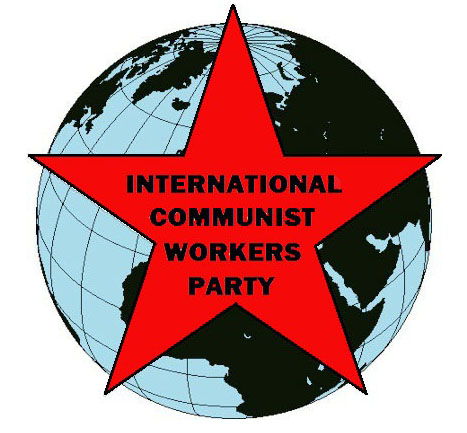
 |
FIGHT FOR COMMUNISM! |
International Communist Workers Party | |
|
| |
Today ICWP knows that all nationalism is wrong and that we need to build one international party to mobilize for communism everywhere.
This was not the line of the old Communist International.
Part III of this series (here) described the debate in the Communist International (CI) after the nationalist Guomindang had turned on China’s communists and murdered many thousands in 1927. This debate did not change the CI’s basic line for colonial countries, that workers and peasants in colonies cannot fight directly for communism or even socialism. They must go through a “bourgeois-democratic revolution” against feudalism and foreign domination, and some capitalists were expected to play a supporting role in that revolution.
In the early 1930s Chinese communists applied this idea by creating rural “soviet” areas where land was confiscated from landlords and distributed to peasants. In 1930 party leader Li Lisan proposed a policy of also confiscating the capitalists’ factories, businesses and banks but this idea was defeated. [Note 1]
Allying with bigger Chinese capitalists would have been impossible for communists in the early 1930s since they were fighting a desperate armed struggle against the Nationalist Guomindang that was trying to destroy the rural soviets. The party only survived by moving to a remote area of northwest China.
The Communist Party of India (CPI) was younger and smaller than China’s, but active in large, hard-fought strikes and in organizing peasants. The CPI denounced the National Congress, led by Gandhi and Nehru. They charged the Congress with siding with the manufacturers, landlords and moneylenders, and “doing all in their power to restrain the masses” in the fight against British imperialism. [Note 2] Some CPI leaders correctly understood that what kept the Indian working class “from turning into an independent leading class force” was the “widespread illusions of an all national united front, which actually meant the subordination of the proletariat to the bourgeoisie.” [Note 3] Thus the CPI pledged a “ruthless war” on the “‘Left’' national reformists” to “isolate them from the workers and the mass of the peasantry.” [Note 4]
Although they rejected the “national reformists” of the National Congress, the CPI’s own program clearly had a nationalist side, to “abolish national slavery, sweeping aside the fetters which check national development, confiscating the land and effecting far-reaching democratic construction of a revolutionary character.” This was to be accomplished by the organization of worker and peasant “soviets,” councils “elected directly from the factories, works and villages.” [Note 5] This worker-peasant government would still allow capitalism, but fight for socialism at some later time after British rule had been overthrown. [Note 6]
In the early 1930s the Indian and Chinese communists refused to fight for the dictatorship of the proletariat and poor peasants, and continued to defend the idea of “revolutionary nationalism.” In practice, however, they actually did fight domestic and foreign capitalists and organized the masses for revolutionary struggle against them. This was soon to change.
In 1931 Japan seized Manchuria and prepared for more conquests in China. In 1933 Hitler’s Nazi party won power in Germany. Hitler’s invasion of Austria in 1934 was briefly opposed by a failed uprising. In 1934 the Chinese communist soviet areas were destroyed by the Guomindang. The USSR reacted to these alarming events by turning sharply to the Right, beginning by joining the League of Nations, an imperialist organization. The Communist International (CI) called a VIIth Congress for the summer of 1935. The congress called for a broad united front against fascism that was to include the anti-revolutionary socialist parties of Europe. Hence it could not aim at the dictatorship of the proletariat, which was postponed indefinitely for developed countries, [Note 7] as it already had been in colonies.
In the colonies the united front was described as an anti-imperialist front, and it was to include the very capitalists that communists had been fighting before 1935. In February 1937 the Communist Party of India said that the united front must include the National Congress and organizations of Indian merchants and industrialists. [Note 8] The Communist Party of China made an alliance against Japan with the nationalist Guomindang. This required a long corrupt negotiation that included kidnapping and then releasing murderous Guomindang leader Chang Kai-shek. [Note 9]
The VIIth Congress tied the CI to nationalism much more completely than anything it had done before. The united front was supposed to be temporary but in fact it marked the end of the old communist movements’ fight for the dictatorship of the proletariat and communism. Only a new communist movement, begun in the 1960s, was able to learn from the various “national liberation” struggles and the Cultural Revolution in China that nationalism always misleads the masses and derails communist revolution. The next article in this series will discuss that crucial step forward.
[Note 1] Ho Kan-Chih, A History of the Modern Chinese Revolution, Bejing, Foreign Language Publishing House, 1959, reprinted by Manika Barua Books and Periodicals, Calcutta, 1977, p. 106.
[Note 2] "Draft Platform of Action of the C. P. of India," International Press Correspondence, vol. 10, #58, Dec. 18, 1930, p. 1218.
[Note 3] Speech by S. P. Bhise to Bombay Textile Workers' Conference, June 20, 1931. Quoted in Shashi Joshi, Struggle for Hegemony in India, 1920-1947, Sage Publications, New Delhi, 1992, vol. 1, p. 305.
[Note 4] Draft Platform, p. 1219.
[Note 5] Ibid, p. 1218.
[Note 6] ibid, p. 1219.
[Note 7] Georgi Dimitrov, "The Fascist Offensive and the Tasks of the Communist International in the Struggle of the Working Class against Fascism, Main Report delivered at the Seventh World Congress of the Communist International," https://www.marxists.org/reference/archive/dimitrov/works/1935/08_02.htm#s6
[Note 8] Kiran Maitra, Marxism in India: From Decline to Debacle, Roli Books, New Delhi, 2012, p. 227.
[Note 9] "Xi'an Incident," https://en.wikipedia.org/wiki/Xi%27an_Incident